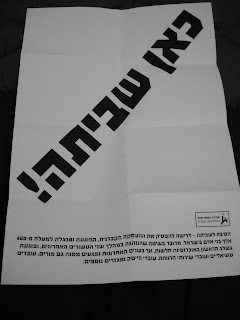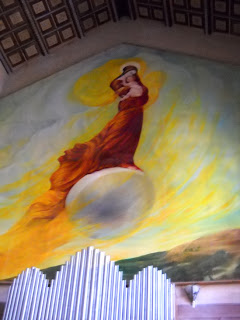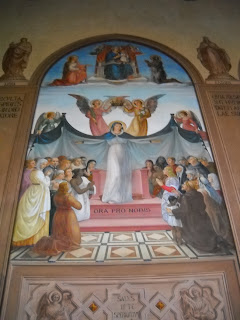Before I get into the tour I took back on September 22nd I wanted to talk about the holiday Rosh Hashanah or the Jewish new year. The holiday began Wednesday at sun set and yesterday was new year's day. You can read my post from last year
here. I mention the pomegranate is traditionally eaten on this holiday along with apple slices dipped in honey. This year I discovered why the pomegranate is eaten.The abundance of seeds represents fruitfulness and the myth is that each fruit has 613 seeds which represent 613 mitzvot. Mitzvot are like commandments you can read about them
here. Everything shuts down for this holiday and most of the students go home to spend the holiday with their families. It is very quiet here in the student village. I wanted to share a new year song they taught us in class it's very catchy and will get stuck in your head.
This rendition is very sad sounding I've never heard this arrangement before. The
second one is more upbeat and closer to the version they taught us at school.
Now on to the tour. Ein Kerem means spring of the vineyard according to my translation. This is the traditional site where John the Baptist was born. In ancient times it was far from Jerusalem. Today it is part of Jerusalem. It is mentioned in the Bible as Beth Hakerem in Jeremiah 6:1 and Nehemiah 3:14. I took 117 pictures on this tour be prepared for a long post. I narrowed down the pictures to show you but there are still quite a few.
This is the Church of the birth place of Saint John the Baptist. There is a nice staircase leading up to the door but I couldn't back up far enough to get the entire building in one picture. This church is owned by the order of Franciscan monks.
This picture is to the right of the previous picture. You are looking at an archaeological site. In Israel holy sites tended to get reused by different religions. This is the remains of a temple to the goddess Venus/Aphrodite. A statue of the goddess was found at this site but it is currently in a museum. I forget which one.
This picture is just before you enter to church it's a cut out in the floor to an earlier Byzantine church. The message is in Greek (I think) and it says All hail the innocent martyrs. The martyrs it refers to are the babies that King Herod ordered killed in order to prevent the Messiah from coming.
We were touring the church around prayer time so as we walked through the church we listened to the nuns singing and praying.
This is the cave area that is where John the Baptist was born.
A peek into someones garden as we were walking through the village. The houses and gardens are beautiful in this area.

Next we visited Notre Dome of the Sisters of Sion. I never would have found this place on my own. It has high walls around it. Ring the bell and tell them you want to visit the garden, it requires a two shequel donation but its totally worth it. It's very peaceful inside. They do have a guest house that you can stay in. We visited for the beautiful views and the cemetery. This is the grave of the monk who founded the place. I can't remember his name. He was originally Jewish but he had a powerful vision of Mary in the position depicted in the statue with glowing hands and he converted to Christianity. Notice the stones placed on the grave. This is a Jewish tradition when you visit a grave you leave a stone behind instead of flowers. There are several different stories as to why you leave a stone. One is that the stone represents earth, the idea of ashes to ashes dust to dust we will all return to the earth one day. The other story I've heard is that the stone represents a part of you that you leave at the grave to honor the deceased.

This is an ossuary from 2,000 years ago. The current cemetery is on the location of a cemetery from 2,000 years ago.
Here is one of the beautiful views. The church with the golden onion domes is the Russian Orthodox Church of Mary Magdalene. The church just below it is the Church of the visitation where we went next.
This is on the opposite hill looking back at Notre Dame of the Sisters of Sion. Notice the terraces on the hill. The terraces were used for agriculture and it is impossible to date them because they were constantly in use and being repaired.
On our way up to the church of the Visitation we passed by this. It's a marriage proposal. Isn't it sweet?
Here is the Church of the Visitation again I couldn't back up far enough to get the entire church in one picture.
Here is a better picture of the painting.
This church has two chapels and upper and a lower chapel. For some reason I didn't take a picture of the entire lower chapel I just took pictures of different elements of the chapel. This well connects to a cistern where Elizabeth and Zechariah got their water.
This painting depicts an angel telling Elizabeth to hide to protect John from Herod's soldiers. Supposedly the rock opened up before her and she went into the cave pictured above to protect John. Notice that Elizabeth is usually painted in a red garment while Mary is traditionally painted in a blue garment.
This picture didn't turn out as good. This is the rock that saved John the Baptist. It is much smaller today because Christian pilgrims would take a piece of it home with them so this is all the is left of the rock.
This is on the back wall of the upper chapel. Since the woman is dressed in red I believe it is Elizabeth holding John.
This is one of the paintings on the wall. This one is of Mary being crowned the Queen of Heaven. Notice the man in a suit on the left side looking right at you. He's the man that paid for the paintings in the chapel.
At the base of the hill is Mary's spring.

This is the spring itself. This is the place where Mary and Elizabeth met. Today it's not very impressive the water is now just a trickle. And there is a sign telling you it's not safe to drink.
Questions from the last post:
Mom-A load of delicates takes about 34 minutes, colors 37 minutes. The time varies a little based on the weight of your clothes.
Uncle Joe- I did buy the Tide Absolute locally. There is Hebrew and Arabic on the sides of the box with directions. There are no irons in the laundry room and I don't own an iron. I take my clothes out of the dryer as soon as it's done to avoid wrinkles.


























































